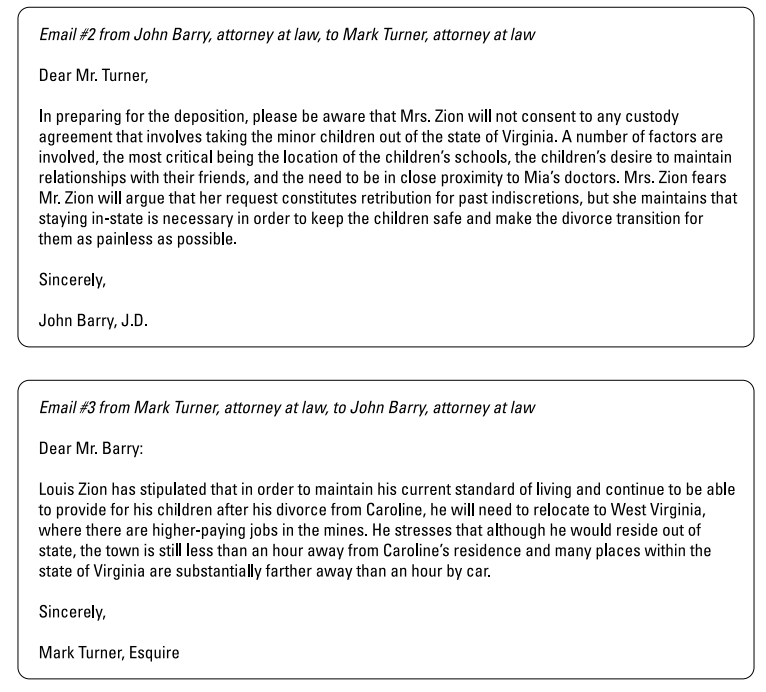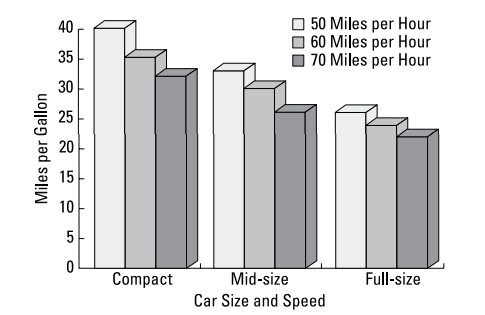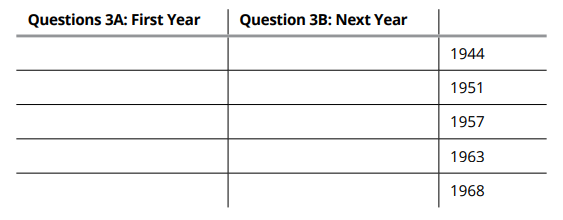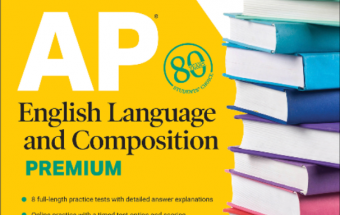GMAT Prep 20242025 for Dummies - Practice Assessment
Section 1: Quantitative
Sample problem solving questions with these 8 questions.
Put down your calculator for these questions; the GMAT doesn’t allow one in the quantitative section.
DIRECTIONS: Choose the best answer from the five choices provided.
1. Section A and section B comprise 1/3 and 1/5 respectively in the figure below. What fraction of the circle is comprised by section C?

(A) 1/4
(B) 2/5
(C) 2/15
(D) 7/15
(E) 8/15
2. If S = {3, 4, 0, 2, 11, 10}, how much greater than the median of the numbers in S is the mean of the numbers in S?
(A) 0.5
(B) 1
(C) 1.5
(D) 2
(E) 2.5
3. Fatim is playing a video coin game in which she has a collection of virtual coins composed of p pennies, d dimes, n nickels, and q quarters. If Fatim adds an additional 3 pennies, 2 dimes, and 1 nickel to her collection, what is the probability that she will pick a penny when she randomly removes a single coin from the collection?
(A) p/(d+n+q)
(B) p/(p+d+n+q)
(C) (p+3)/(d+n+q+3)
(D) (p+3)/(p+d+n+q+3)
(E) (p+3)/(p+d+n+q+6)
4. The positive integer x is divisible by 15. If √x < 15, which of the following could be the value of x/15?
(A) 14
(B) 15
(C) 16
(D) 17
(E) 18
5. If n is an integer and 11 x 10n < 1/10, which of the following is the greatest possible value of n?
(A) –4
(B) –3
(C) –2
(D) –1
(E) 0
6. What is the value of (32+322)/32?
(A) 33
(B) 34
(C) 64
(D) 1,024
(E) 1,056
7. Machine X produces 1,050 components in 5 hours when working alone at a constant rate. Machine Y produces the same number of components in 7.5 hours when working alone at a constant rate. How many components does Machine Y produce if both devices operate simultaneously for T hours and produce 1,050 components?
(A) 140
(B) 210
(C) 420
(D) 525
(E) 630
8. Which of the following equations have both 3 and -3 in the solution set?
I. x = √9
II. x2 = 9
III. x4 = 81
(A) I only
(B) II only
(C) III only
(D) II and III only
(E) I, II, and III
Section 2: Verbal
Sample verbal question types with these 8 questions.
DIRECTIONS: Follow these directions for each of the two question types:
• Questions 5, 6, & 7 are reading comprehension questions: Choose the best answer to every question based on what is stated or implied in the passage.
• Questions 1, 2, 3, 4, & 8 are critical reasoning questions: Pick the answer choice that best answers the question about the argument provided.
1. The Earth’s magnetic field has reversed a number of times in its history. Before the poles actually flip, the magnetic field weakens and the magnetic poles drift away from “true” north and south. On average, the magnetic North and South Poles flip about once every 200,000 years. The last time the poles flipped was 780,000 years ago. Therefore, the poles are in the process of reversing.
Which of the following, if true, would most strengthen the argument above?
(A) Magnetic north has recently been moving toward closer alignment with “true” north.
(B) Sometimes the magnetic fields go for over one million years without reversing.
(C) The Earth’s atmosphere has warmed by about one degree Celsius over the past century.
(D) The strength of the magnetic field has declined by over 10 percent since 1845, the first year it was measured.
(E) The location of the magnetic poles has remained unchanged for as long as magnetic compasses have been in use.
2. Many names that people think of as Irish were actually brought to Ireland by the AngloNorman invasion of Ireland in the 12th century. Names like Seamus, Patrick, and Sean are so widespread because of the Catholic Church’s requirements that Irish sons and daughters be named after saints. Seamus is the Gaelic version of James, and Sean is the Gaelic version of John. Criminal laws in Ireland from the 1500s to the 1900s forbade parents from giving their children traditional Irish names like Cathal, Aodh, and Brian. Nowadays parents are free to give their children these long-forgotten, truly Irish names.
Which of the following inferences can be drawn from the statements above?
(A) Only Irish names used in Ireland before the 12th century are “traditional.”
(B) Irish parents prefer to give their children names that are as traditionally Irish as possible.
(C) Parents in Ireland should now give their children names like Cathal, Aodh, and Brian.
(D) Even after hundreds of years of use, names like Seamus, Patrick, and Sean are still not “truly Irish.”
(E) Criminal laws in Ireland are unnecessarily punitive.
3. The Springfield Junior Philharmonic (SJP) has cemented its reputation as the premier children’s musical organization due in large part to major donations from former members who enjoy attending the annual holiday concert. Although the SJP is widely regarded as being the best organization of its kind, the holiday concert was canceled this year; so SJP will experience a resulting reduction in donations.
The argument above relies on which of the following assumptions about SJP?
(A) SJP’s reputation as the premier children’s musical organization is enhanced by the amount of money it receives from donors.
(B) SJP alums will have at least as much money to donate next year as they did this year.
(C) The SJP holiday concert will likely be canceled next year as well.
(D) Some SJP alums contribute to the organization because they enjoy attending the annual holiday concert.
(E) Contributions from alums are necessary for SJP to be able to play its annual holiday concert.
4. Following a route already taken by other industrialized countries, the Food and Drug Administration recently unveiled nine new graphic warning labels that will soon adorn all cigarette packs sold in the United States. Although the addition of the new labels marks the first time in a quarter-century that the warnings have included imagery of the dangerous effects of smoking, heated debate arose over just how graphic the images should be, with the FDA ultimately withdrawing a number of images deemed too graphic. Some, however, argue that _______.
Which of the following most logically completes the passage?
(A) Including warning labels will be ineffective, because the primary issue is not one of awareness but physical addiction.
(B) No substantial evidence indicates that pictorial warning labels are effective.
(C) The addition of the new pictorial warning labels are just another way the government is encroaching on the rights of Americans.
(D) The images ultimately selected are too tame, and if the FDA is to go as far as including images at all, it should not hold back from showing the full effects of smoking, however ugly they may be.
(E) If such imagery will be added to cigarette packs, then images of drunk driving accidents and liver disease should be added to all alcoholic products.
Questions 5–7 refer to the following passage, which is from Applied Turfgrass Science and Physiology, by Jack Fry and Bingru Huang (John Wiley & Sons, Inc.).
________________________________________________________________
Plant injury resulting from high light intensity is due not to the light per se but to an excess of light energy over that utilized by photosynthesis. When light reaching the leaves is not used for photosynthesis, the excess energy triggers production of free radicals that can damage cells (oxidative damage). This often occurs when light intensity is high but photosynthesis is inhibited due to stress from temperature extremes, drought, or excessive soil water. When light intensity is at a low level where photosynthesis and respiration reach equilibrium and the net carbon gain is zero, no plant growth will
occur. This light level is the light compensation point (LCP). Leaves exposed to light levels below the LCP for an extended period of time will eventually senesce. . . . LCP var[ies] among turfgrass species and with temperature and CO2 concentration.
Under high irradiance, warm-season grasses maintain a higher rate of photosynthesis than coolseason grasses. However, cool-season grasses have a lower LCP and exhibit higher photosynthetic rates under low light levels compared to warm-season grasses. Photosynthetic rates of both warm-season and cool-season grasses exhibit a diurnal pattern on clear, sunny days, increasing from sunrise, reaching a maximum around noon, and then decreasing to the lowest levels by sunset.
Photosynthesis is affected by light duration because it occurs only during daylight. Increasing light duration may not increase the rate of carbon fixation, but the total amount of carbon fixed by photosynthesis will increase due to increased light exposure. Sunlight has all the colors of visible light and is composed of different wavelengths. Not all wavelengths are equally effective in driving photosynthesis, however. Most photosynthetic activity is stimulated by blue and red wavelengths — chlorophylls absorb blue and red light and carotenoids absorb blue light. Green light is reflected, thus giving plants their green color. Green-yellow and far red are transmitted through the leaf.
5. The authors of the passage are primarily concerned with
(A) discussing the impacts of light energy and photosynthesis on warm-season and cool-season grasses.
(B) arguing in favor of warm-season grasses, which are less prone to oxidative damage than cool-season grasses.
(C) exploring the important role of photosynthesis in sustaining turfgrass production.
(D) comparing different kinds of turfgrasses according to their responses to various levels of light energy.
(E) clarifying the scientific details of recent research into the photosynthesis of turfgrass.
6. According to the passage, which of the following is an important difference between warm-season and cool-season grasses?
(A) Cool-season grasses can better withstand higher light intensities such as those found nearer the equator, while warm-season grasses are better suited to northern climates.
(B) Warm-season grasses can handle the higher light levels of summer, while cool-season grasses can grow during the lower light conditions of winter.
(C) Most of the photosynthesis in warmseason grasses takes place during the day, while cool-season grasses usually photosynthesize at night.
(D) Warm-season grasses use only the blue and red spectrums of light for photosynthesis, while reflecting harmful green light.
(E) Excess light reaching cool-season grasses can be responsible for damage to the plant’s cells, while warm-season grasses are unharmed.
7. Which of the following can be inferred from the discussion on oxidative damage in the first paragraph?
(A) Oxidative damage most frequently occurs about one hour after sunrise and one hour before sunset.
(B) Homeowners should water their lawns as often as possible because damage to grass is caused by drought and not simply by light intensity.
(C) Oxidative damage to grass occurs when light reaching the leaves is not used for photosynthesis and, therefore, forms carbon fixation.
(D) Damage to grass occurs because of the high intensity of light and homeowners can do nothing to preserve their lawns.
(E) Both overwatering and underwatering a lawn can inhibit photosynthesis and damage grass.
8. I bought a pair of glasses from an optometrist. One of the lenses regularly pops out of the frame. Therefore, this optometrist doesn’t know how to make a good pair of glasses.
The reasoning in the argument is most vulnerable to criticism on the grounds that the argument
(A) does not allow the optometrist a chance to offer a defense.
(B) does not consider the possibility that other optometrists also make defective frames.
(C) criticizes the optometrist’s use of a particular technique when making glasses.
(D) jumps to the conclusion that the defect in the glasses must be due to the optometrist’s lack of skill.
(E) accuses the optometrist of deliberately sabotaging the glasses.
Section 3: Data Insights
Sample data insights question types with these 8 questions.
The following four integrated reasoning questions have been modified to work on paper. Their online format contains some features that cannot be duplicated exactly in this pretest, but these questions provide you with enough similarity to gain an understanding of the approach they require. Each question has multiple parts; you must answer every part correctly to receive credit for the question. If needed, you can use a simple calculator to answer these questions.
DIRECTIONS: Follow these directions for each of the four integrated reading question types:
1. The multi-source reasoning Question Set #1 presents you with several different sets of data. Read through the data and examine the information you need to answer the questions.
2. The two-part analysis Question Set #2 has two solutions. Make one selection in the first column and one selection in the second column from a list of options in the third column of a three-column response table. You must pick one correct answer in the first column and one correct answer in the second column to get credit for the question.
3. For graphics interpretation Question Set #3, examine the graph and select the answer from the list that most accurately completes the statement.
4. Analyze the data in the table analysis Question Set #4 to determine which of the two opposing answer choices most clearly defines the accuracy of the statements.
Question Set 1


DIRECTIONS: Consider each statement and determine whether the information in the three emails allows you to make the specific inference. Place a check mark under Inferable if it can be inferred that the statement is true. Otherwise, place a check mark under Not Inferable.

Question Set 2
________________________________________________________________
Automobile gasoline consumption is directly related to pollutant emissions. The following graph represents how gasoline mileage is affected by freeway driving speeds of 50, 60, and 70 miles per hour (mph) for three different types of cars: compact, mid-size, and full-size.

DIRECTIONS: Complete the sentences based on this information.
2A The _________will emit the most pollutants on a 100-mile trip.
(a) compact car driven at 50 mph
(b) mid-sized car driven at 70 mph
(c) full-sized car driven at 50 mph
(d) full-sized car driven at 60 mph
2B The best estimate of average miles per gallon for a full-size car driven at 55 mph is ______.
(a) 20
(b) 23
(c) 25
(d) 32
(e) 37
Question Set 3
Two different animal populations can be approximated with different equations. Let x represents the number of years since 1950; x = 0 when the year is 1950; and let y represent the animal population in thousands. The relationship between the number of years since 1950 and population numbers for the first animal population can be described by the quadratic equation y = (4 - x)2. The relationship between the number of years since 1950 and population for the second animal population can be described by the linear equation y = 6x + 3.
DIRECTIONS: In the table, place a check mark for the first year when the two animal populations were equal in the first column and a check mark for the next year the two animal populations were equal in the second column. Mark only one answer in each column.

Question Set 4
A water bottle manufacturer produces a line of water bottles. The following table shows the characteristics of the water bottles.

DIRECTIONS: For each of the following statements, place a check mark under Consistent if the statement is consistent with the information provided. Otherwise, place a check mark under Inconsistent.

DIRECTIONS: Follow these directions for each of the data sufficiency questions:
For each data sufficiency problem examine the question and two statements, labeled (1) and (2), decide whether the statements given are sufficient for answering the question, and select one of the answer choices that follow.
5. Mateo and Tristan each received a salary increase. Which one received the greater dollar increase?
(1) Mateo’s salary increased 4.5 percent.
(2) Tristan’s salary increased 7.5 percent.
(A) Statement (1) alone is sufficient, but Statement (2) alone is not sufficient.
(B) Statement (2) alone is sufficient, but Statement (1) alone is not sufficient.
(C) Both statements together are sufficient, but neither statement alone is sufficient.
(D) Each statement alone is sufficient.
(E) Statements (1) and (2) together are not sufficient.
6. What is the value of the prime number p?
(1) 11 < p − 2 < 17
(2) p2 = 289
(A) Statement (1) alone is sufficient, but Statement (2) alone is not sufficient.
(B) Statement (2) alone is sufficient, but Statement (1) alone is not sufficient.
(C) Both statements together are sufficient, but neither statement alone is sufficient.
(D) Each statement alone is sufficient.
(E) Statements (1) and (2) together are not sufficient.
7. At a summer camp, all 200 campers play soccer or tennis or both. If 50 of the campers do not play tennis, how many campers play both tennis and soccer?
(1) A total of 170 of the campers play soccer.
(2) Less than 50 of the campers do not play soccer.
(A) Statement (1) alone is sufficient, but Statement (2) alone is not sufficient.
(B) Statement (2) alone is sufficient, but Statement (1) alone is not sufficient.
(C) Both statements together are sufficient, but neither statement alone is sufficient.
(D) Each statement alone is sufficient.
(E) Statements (1) and (2) together are not sufficient.
8. A supermarket sells mangos for $1.50 each and cantaloupes for $2.00 each? How many mangos did the supermarket sell today?
(1) The number of mangos sold today is 20 more than twice the number of cantaloupes sold.
(2) Today the supermarket received a total of $155 from the sale of mangos and cantaloupes.
(A) Statement (1) alone is sufficient, but Statement (2) alone is not sufficient.
(B) Statement (2) alone is sufficient, but Statement (1) alone is not sufficient.
(C) Both statements together are sufficient, but neither statement alone is sufficient.
(D) Each statement alone is sufficient.
(E) Statements (1) and (2) together are not sufficient.



-340x215.png)


